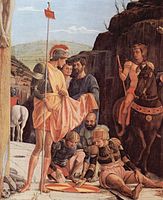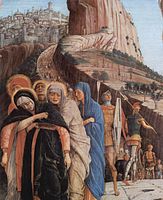San Zeno Altarpiece (Mantegna)
| San Zeno Altarpiece | |
|---|---|
 | |
| Artist | Andrea Mantegna |
| Year | c. 1456–1459 |
| Medium | Tempera on panel |
| Dimensions | 212 cm × 460 cm (83 in × 180 in) |
| Location | Basilica di San Zeno, Verona |
The San Zeno Altarpiece is a
Patron and commission
The San Zeno Altarpiece was commissioned around 1456 to 1459 by Gregorio Correr, a Venetian nobleman, humanist scholar, and administrator for and abbot of the Church of San Zeno.[7] The San Zeno altarpiece was commissioned and made to depict a heavenly realm.[5][7] This was intended so the viewers would aspire for a position in the "court of heaven" in communion with the religious figures portrayed in the altarpiece.[1][3][5] Furthermore, St. Zeno the patron saint of Verona, is believed to have introduced Christianity to Verona, therefore this altarpiece is named in his honor.[3] After his work on the San Zeno Altarpiece, Mantegna finally arrived in Mantua in the year 1460 to serve as the court artist to the House of Gonzaga, the leading princely family of the city.[5] Mantegna had actually been hired by Ludovico III Gonzaga, Marquis of Mantua, three years before, in 1457, but disagreements about Mantegna's pay and status delayed his arrival and it was during this period of postponement that he worked on the San Zeno Altarpiece.[5][7]
Style, subject and description of the San Zeno Altarpiece
The San Zeno Altarpiece is often considered to be a pictorial rendition of the artist Donatello's sculpted bronze reliefs (known as the Santo Altarpiece) made for the high altar dedicated to Sant'Antonio (c. 1446-1453) in the Basilica of Saint Anthony of Padua.[6][5][7] While sometimes described as "lost" this work by Donatello survives but was incorrectly restored in the 19th century, thereby losing some of the artist's initial design and it has been argued by scholars that Mategna's work may better illustrate what Donatello originally intended.[6]
Mantegna incorporated noticeably bright and rich colors of reds, blues, yellows and green that was likely a reaction to earlier critics who had negatively commented on the opaque colors in the famous frescos painted from 1454 to 1457 (destroyed in 1944) in the Ovetari Chapel.[7] Despite seeing other artists change their color schemes he stuck to his own ideas and own techniques, which differentiated Mantegna from other Renaissance artists.[8] The scholars Steven Zucker and Beth Harris note that the ancient, classical "past" is mostly painted in shades of grays, painted in the style of grisaille (an exception is the colorful garlands of fruit that are tied with red ribbons), while the Christian elements, show in the "present", are denoted by the use of bright, saturating colors.[3]
The altarpiece consists of a frame, a central painting separated into three main sections, and on the bottom, a predella with three paintings that depict biblical scenes.[7]
Central and side panels
The central section of the painting displays the
Mantegna's depiction of the figures, specifically that of St. John the Baptist, illustrates his use of
Predella
On the bottom portion of the altarpiece, three paintings are displayed in the predella of the altarpiece. These paintings portray biblical scenes that occurred in Jerusalem, like the Crucifixion of Jesus and the Agony in the Garden.[5][6] While the altarpiece remains in situ, the three paintings of the predella were stolen by Napoleon and have not been returned; those seen in the altarpiece today are all copies, while the originals remain in two different French museums.[6] The image of the Crucifixion is at the Louvre Museum in Paris, while the scenes of the Resurrection and Agony in the Garden are in Tours at the Musée des Beaux-Arts.[4] Despite being smaller components of this altarpiece, these paintings display Mantegna's attention to detail and precision as an artist in his quest to render a memorable and historical depiction of the Passion of Christ in Italian art.[6][7]
Frame
The frame is carved from wood that has been gilded. Four
While the frame is original, the decoration that originally ornamented the center of the pediment has been lost.[6]
Imagery, symbolism, and technique
Oil lamp, ostrich egg, and rosary
Hanging above the Madonna and in between the festooned garlands hangs a burning oil lamp with a flame, surmounted by a large ostrich egg, symbolizing the Virgin birth.[6] Ostrich eggs were typically hung over altars that were dedicated to the Virgin Mary and can be found in later Italian Renaissance paintings, including Pierro della Francesca's Brera Madonna(1472) and Giovanni Bellini's San Zaccaria Altarpiece (1505).[6] Below the oil lamp is a strand of red rosary beads.[6]
References to the East: Pseudo-Arabic Script and Oriental Carpet
Mantegna utilized
Linear perspective
Another technique Mantegna employed in the San Zeno Altarpiece was linear point perspective in order to enhance the continuous image behind the pillars so as to make the image appear more realistic to the external world.[3] The illusionism of the image was further achieved through the real four wooden carved columns of the frame, which are located in the space of the viewer, are unified with the painted garlands that are located in the immediate foreground of the pictorial space.[1][3] Moreover, Mantegna's use of perspective allows the saints and several of the architectural elements and decorations to recede into the space, furthering the illusion of depth.[1][3] Mantenga's convincing spatial depth found in the San Zeno Altarpiece began a stylistic and technical tradition that would continue on through the Cinquecento in other illusionistic altarpieces by Giovanni Bellini, including: San Giobbe Altarpiece (1487); Frari Triptych (1488); San Zaccaria Altarpiece (1505).[6]
Provenance
The San Zeno Altarpiece was originally created for the Basilica of San Zeno in the town of Verona in northern Italy and currently still stands there.[3] As described above (see: predella), Napoleon stripped the panel apart, taking the central panel, as well as the three predella paintings to Paris in 1797.[3] Only the central panel was returned after Napoleon lost power in 1815, but the three original predella have never been returned, and thus those seen in the altarpiece today are copies.[3][7]
Predella
-
The central panel (The Crucifixion)
-
Detail of the central panel
-
Detail of the central panel
References
- ^ JSTOR 469365– via JSTOR.
- ^ Mantegna, Andrea (April 1456), "La Crucifixion", Louvre, retrieved 2023-04-24
- ^ a b c d e f g h i j k l m n o p q r s t Zucker, Steven; Harris, Beth (2015). "Andrea Mantegna, San Zeno Altarpiece". smarthistory.org. Retrieved 2023-04-18.
- ^ a b De Marchi, Andrea; Del Puppo, Alessandro; Eveno, Myriam; Gilet, Annie; Ravaud, Elisabeth; Winling, Christel (June 2009). "Andrea Mantegna: La Prédelle de San Zeno de Vérone 1457-1459" (PDF). Musée des Beaux-Arts / Tours.
- ^ OCLC 755982774.
- ^ OCLC 430523019.
- ^ OCLC 57625761.
- OCLC 793996522.
- ^ OCLC 1200306384.
External links
| External videos | |
|---|---|
 A study made for the painting, now at the Getty Museum A study made for the painting, now at the Getty Museum | |



